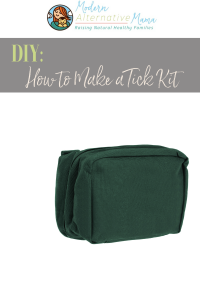Written by Lindsey
Every spring, I’m so excited to shed the shackles of winter and embrace the sweet smell of spring. I fervently take to hiking and foraging for my spring favorites, forgetting my usual cautiousness. It only takes one or two trips before I’m reminded of that tiny outdoor foe, the tick.
It’s been years since we’ve been bitten (we always catch them crawling on our clothes), but every year, I swear the next I’ll be ready. Well, the time has come. I am building my tick kit, and I want to share the whys and hows with you so you can be ready, too.
Ticks: What Are They and What You Need To Know
If you read our blog, Everything You Need to Know About Parasites, you know ticks are small invertebrates that feed on blood. They often carry diseases, the most well-known being Lyme disease. When they bite, they exchange fluid as well as suck out the blood, and that is how they spread disease. A few others are Rocky Mountain spotted fever, babesiosis, Colorado tick fever, and alpha-gal syndrome, to name a few.
Like many other invertebrates, they have different sizes based on the type and stage they are in development. For example, at the beginning of its life cycle, a deer tick is the size of the tip of a pencil.
How to Make a Tick Kit
So you found a tick on you or someone you love. Now what? Instead of scrambling and panicking, here is a comprehensive list of what to do and what you need to do it.
Tick Remover
When you remove a tick, you want to remove the whole thing. This can be a little tricky if the head is really buried. Some people can safely remove ticks with their fingers; others are more comfortable with a device to help remove the whole tick. Here are a few recommended devices:
- Tweezers
- Tick Key
- Tick Stick
Small Jar/Plastic Bag/Tape
While I don’t usually advocate for plastic bags, I’ll look the other way on this one. If you like, you can send the tick out for testing to see what diseases it has. We had a tick bite during hunting season and opted to send it out for testing. If you decide you want to send your tick out for testing, here are a few recommendations:
- Lyme & Tick-Borne Disease Testing & Statistics | PA Tick Research Lab (ticklab.org)
- TickCheck Tick Testing – Laboratory Tick Testing Services for Lyme & Tick-Borne Diseases
Here is an example of what the results might look like:
Drawing Salve
Once you’ve removed the tick, you can apply drawing salve to the bite. Drawing salve is made up of herbs and minerals that help pull toxins out of the body through the skin. It has gotten a bad rep, mainly because of the herb bloodroot. There are plenty of drawing salves that have safe ingredients. We use Earthley’s Black Drawing Salve, made with activated charcoal and bentonite clay, both of which have drawing properties. You can also try making a DIY: Black Drawing Salve.
Post-Bite Options
Once you’ve been bitten, you can take matters into your own hands and handle things as if the tick is diseased, wait to get test results back before doing anything, or wait for symptoms to appear.
Conventional Options
The standard care plan for a tick bite is a long course of doxycycline, a heavy-hitting antibiotic. It is usually recommended to take a course of antibiotics for two to four weeks.
Natural Options
Two remedies are consistently recommended post-tick bite. The first is Ledum Palustre. This homeopathic remedy is known for its inflammatory properties and is also an antioxidant. You can take this when bitten to help get ahead of any potential infection. For dosing, read here.
The second is the Buhner Protocol. Steven Buhner has several books and has developed a protocol of natural remedies to take if infected with a tick-borne disease. It is discussed more in-depth there.
Other things you can do to support the body include:
- Immune system support with elderberry: You can make elderberry syrup (check out our Ultimate Elderberry Syrup Collection). If you’re not into DIYs, you can use Earthley’s Elderberry Elixir.
- Increase vitamin C intake: A super antioxidant, vitamin C is in many foods like peppers, oranges, strawberries, kiwi, and broccoli. If you’re looking for an easy way to increase vitamin C, check out Earthley’s Vita-C Herbal Tincture or Earthley’s Immune-Aid, which comes in powder or capsules.
I can now hike a little more relaxed, now that I have my kit assembled. Having a plan and the tools in case of a tick bite are all you need to embrace being outdoors.









Hi, great article! I plan to make my tick kit today after reading this!
Two questions, in the article it says… “ Here is an example of what the results might look like” in regards to the testing- I do not see the example.
Also, it says, “ For dosing, read here” in regards to the Ledum and there is not a link or anything. Am I missing a few things in your writing? Thank you! Tina
Hi Tina! Sorry about that! Occasionally, the graphics don’t show up inside the blog content (we are working on that). unfortunately, I can’t add pictures here in the comments either. My son was diagnosed with Lyme a few years ago so when we pull off a tick, to err on the side of safety, we do 1 30c Ledum tablet a day for 3 days. If symptoms appear, then we add on to that. You can read more about that experience here: https://modernalternativemama.com/2023/05/17/natural-remedies-for-lyme-disease/
Wondering if one were to take the antibiotic, could one do all the natural remedy mentioned here too? Or would you have to pick one or the other